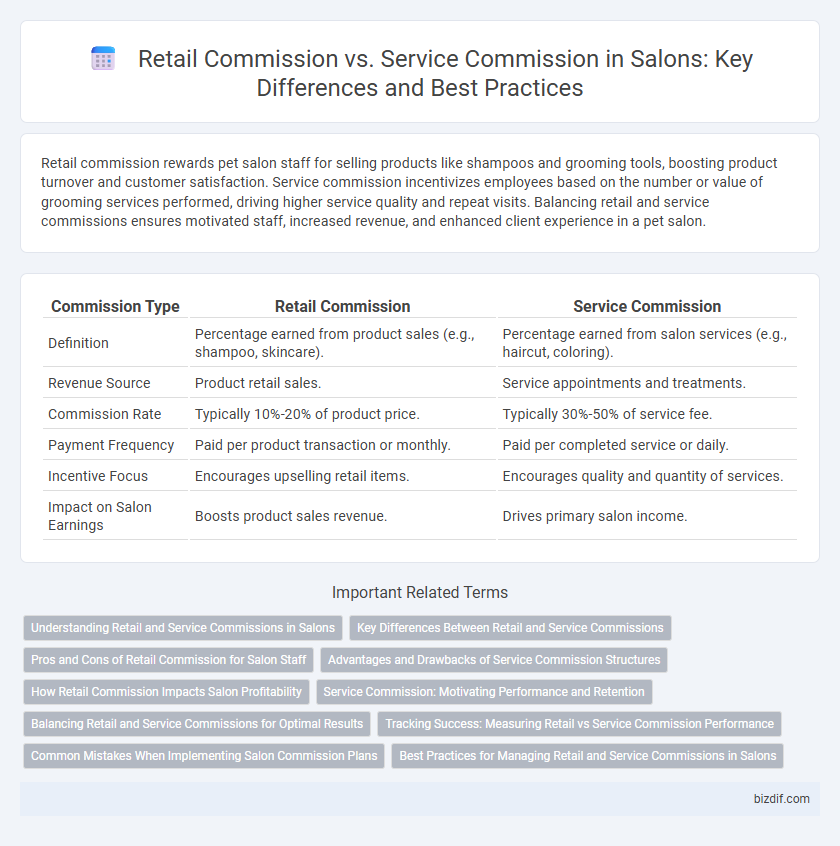Retail commission rewards pet salon staff for selling products like shampoos and grooming tools, boosting product turnover and customer satisfaction. Service commission incentivizes employees based on the number or value of grooming services performed, driving higher service quality and repeat visits. Balancing retail and service commissions ensures motivated staff, increased revenue, and enhanced client experience in a pet salon.
Table of Comparison
| Commission Type | Retail Commission | Service Commission |
|---|---|---|
| Definition | Percentage earned from product sales (e.g., shampoo, skincare). | Percentage earned from salon services (e.g., haircut, coloring). |
| Revenue Source | Product retail sales. | Service appointments and treatments. |
| Commission Rate | Typically 10%-20% of product price. | Typically 30%-50% of service fee. |
| Payment Frequency | Paid per product transaction or monthly. | Paid per completed service or daily. |
| Incentive Focus | Encourages upselling retail items. | Encourages quality and quantity of services. |
| Impact on Salon Earnings | Boosts product sales revenue. | Drives primary salon income. |
Understanding Retail and Service Commissions in Salons
Retail commissions in salons typically involve a percentage earned on the sale of beauty products, incentivizing staff to promote product recommendations. Service commissions are earned based on the value of services provided, such as haircuts, coloring, or treatments, encouraging high-quality service delivery. Understanding the difference helps salons design compensation plans that balance product sales with exceptional customer service to maximize revenue.
Key Differences Between Retail and Service Commissions
Retail commissions in salons typically apply to product sales, rewarding employees based on the dollar value of retail items sold. Service commissions are earned through the provision of salon services like haircuts or treatments, often calculated as a percentage of the service fee. Key differences include the commission basis--retail commissions focus on physical product sales, while service commissions derive from labor fees--and how each incentivizes employees to promote either product retail or service excellence.
Pros and Cons of Retail Commission for Salon Staff
Retail commission in salons incentivizes staff to sell hair care products and beauty merchandise, often increasing overall revenue and customer satisfaction through personalized product recommendations. However, focusing heavily on retail commissions can lead to staff prioritizing product sales over service quality, potentially diminishing client trust and repeat visits. Balancing retail commission with service commission helps maintain a high standard of customer care while boosting retail sales effectively.
Advantages and Drawbacks of Service Commission Structures
Service commission structures in salons motivate staff by directly linking earnings to the quality and volume of services performed, enhancing performance and client satisfaction. However, reliance on service commission may lead to inconsistent income for employees and potential overtreatment as stylists strive to maximize earnings. Balancing service commissions with base salaries can mitigate income volatility while maintaining high service standards.
How Retail Commission Impacts Salon Profitability
Retail commission structures in salons directly influence profitability by incentivizing staff to promote product sales alongside services, increasing overall revenue streams. Higher retail commissions can boost employee motivation to recommend and sell products, improving profit margins due to the higher markup on retail items compared to services. Balancing retail and service commissions ensures sustained income growth while maintaining quality client service and satisfaction.
Service Commission: Motivating Performance and Retention
Service commission directly links stylist earnings to their performance, incentivizing higher-quality customer service and repeat bookings. This targeted compensation model fosters a motivated workforce, reducing turnover and enhancing client satisfaction. Salons adopting service commissions typically observe increased staff retention rates and improved overall revenue through consistent service excellence.
Balancing Retail and Service Commissions for Optimal Results
Balancing retail and service commissions in salons is crucial for maximizing revenue and staff motivation, with retail commissions typically ranging from 10% to 20% and service commissions between 30% and 50%. Offering tiered commission structures that reward both product sales and service excellence encourages stylists to promote retail items without compromising the quality of client services. Optimizing this balance drives increased overall profitability, improves client satisfaction, and fosters a motivated, well-rounded team.
Tracking Success: Measuring Retail vs Service Commission Performance
Tracking success in salons involves analyzing retail commission versus service commission performance through key metrics like sales volume, client retention, and average transaction value. Retail commission performance often reflects the effectiveness of product recommendations and inventory turnover, while service commission centers on appointment frequency and service upsells. Utilizing salon management software enables detailed tracking and reporting, helping optimize commission structures for maximized profitability and stylist motivation.
Common Mistakes When Implementing Salon Commission Plans
Common mistakes when implementing salon commission plans include confusing retail commission with service commission, leading to unclear incentives that reduce team motivation and overall revenue growth. Many salons fail to set distinct commission rates for product sales and styling services, which can result in employees focusing on one revenue stream at the expense of the other. Accurate tracking and clear communication of commission structures for both retail items and service-based earnings are essential to prevent disputes and optimize staff performance.
Best Practices for Managing Retail and Service Commissions in Salons
Implement transparent commission structures by clearly differentiating between retail and service commissions, ensuring stylists receive appropriate incentives for product sales and client services. Tracking sales data through salon management software enables accurate commission calculations and helps identify high-performing staff, optimizing morale and profitability. Establishing consistent payout schedules and fair commission rates aligned with industry benchmarks maximizes motivation and supports sustainable salon growth.
Retail commission vs Service commission Infographic

 bizdif.com
bizdif.com